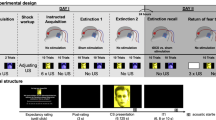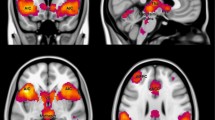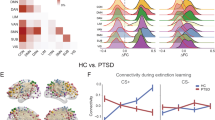Abstract
Transcranial direct current stimulation (tDCS) has been studied to enhance extinction-based treatments for anxiety disorders. However, the field shows conflicting results about its anxiolytic effect and only a few studies have observed the extinction of consolidated memories. We looked to study the effect of offline 1 mA tDCS over the right dorsolateral pre-frontal cortex across the fear pathways, in consolidated fear response during delayed extinction. Participants (N = 34 women) underwent in a two-day fear conditioning procedure. On day 1, participants were assigned to the control group (N = 18) or the tDCS group (N = 16) and went through a fear acquisition procedure. On day 2, the tDCS group received 20 min tDCS before extinction and while inside the MRI scanner. The control group completed the extinction procedure only. The tDCS session (for the tDCS group) and the fMRI scan (for both groups) were completed just on the second day. Univariate fMRI analysis showed stimulation-dependent activity during late extinction with the tDCS group showing decreased neural activity during the processing of threat cues (CS +) and increased activity during the processing of safety cues (CS −), in prefrontal, postcentral and paracentral regions, during late extinction. ROI to whole-brain psychophysiological interaction (PPI) analysis showed the tDCS effect on the connectivity between the left dorsolateral prefrontal cortex three cortical–amygdalo–hippocampal–cerebellar pathway clusters during the processing of the CS + in late extinction (TFCE corrected; p < 0.05). Increased neuronal activity during the processing of safety cues and stronger coupling during the processing of threat cues might be the mechanisms by which tDCS contributes to stimuli discrimination.



Similar content being viewed by others
Data availability
In line with Open Science practices, fMRI, SCR and -Self-reports raw data, scripts for stimuli presentation, preprocessing and analysis may be found at https://osf.io/umy7c/.
Code availability
Not applicable.
References
Abend R, van ’t Wout M (2018) Commentary: augmentation of fear extinction by transcranial direct current stimulation (tDCS). Front Behav Neurosci. https://doi.org/10.3389/fnbeh.2018.00121
Abend R, Jalon I, Gurevitch G, Sar-El R, Shechner T, Pine DS, Hendler T, Bar-Haim Y (2016) Modulation of fear extinction processes using transcranial electrical stimulation. Transl Psychiatry 6:e913–e913. https://doi.org/10.1038/tp.2016.197
Agren T, Engman J, Frick A, Bjorkstrand J, Larsson E-M, Furmark T, Fredrikson M (2012) Disruption of reconsolidation. Science 337:1550–1552. https://doi.org/10.1126/science.1223006
Alvarez RP, Biggs A, Chen G, Pine DS, Grillon C (2008) Contextual fear conditioning in humans: cortical-hippocampal and amygdala contributions. J Neurosci off J Soc Neurosci 28:6211–6219. https://doi.org/10.1523/JNEUROSCI.1246-08.2008
Antal A, Bikson M, Datta A, Lafon B, Dechent P, Parra LC, Paulus W (2014) Imaging artifacts induced by electrical stimulation during conventional fMRI of the brain. NeuroImage Neuro-Enhanc 85:1040–1047. https://doi.org/10.1016/j.neuroimage.2012.10.026
Arcoraci V, Spina E (2015) Safety and tolerability of anxiolytics/sedative-hypnotics, In: Pharmacovigilance in Psychiatry. Springer International Publishing, Cham, pp 191–207. https://doi.org/10.1007/978-3-319-24741-0
Baldwin D, Woods R, Lawson R, Taylor D (2011) Efficacy of drug treatments for generalised anxiety disorder: systematic review and meta-analysis. BMJ 342:d1199. https://doi.org/10.1136/bmj.d1199
Baxter AJ, Scott KM, Vos T, Whiteford HA (2013) Global prevalence of anxiety disorders: a systematic review and meta-regression. Psychol Med 43:897–910. https://doi.org/10.1017/S003329171200147X
Boucsein W, Fowles DC, Grimnes S, Ben-Shakhar G, Dawson ME, Filion DL (2012a) Publication recommendations for electrodermal measurements. Psychophysiology 49:1017–1034. https://doi.org/10.1111/j.1469-8986.2012.01384.x
Boucsein W (2012b) Electrodermal activity, 2nd ed. Springer, US, Boston. https://doi.org/10.1007/978-1-4614-1126-0
Bouton ME (1993) Context, time, and memory retrieval in the interference paradigms of Pavlovian learning. Psychol Bull 114:80–99. https://doi.org/10.1037/0033-2909.114.1.80
Bouton ME (2002) Context, ambiguity, and unlearning: sources of relapse after behavioral extinction. Biol Psychiatry 52:976–986. https://doi.org/10.1016/s0006-3223(02)01546-9
Bradley M, Lang P (1999) International affective digitized sounds (IADS): stimuli, instruction manual and affective ratings. University of Florida, Gainesville
Canavarro MC (2007) Inventário de Sintomas Psicopatológicos (BSI): Uma revisão crítica dos estudos realizados em Portugal., in: Avaliação Psicológica: Instrumentos Validados Para a População Portuguesa. Quarteto Editora, Coimbra, pp 305–330
Carpenter JK, Andrews LA, Witcraft SM, Powers MB, Smits JAJ, Hofmann SG (2018) Cognitive behavioral therapy for anxiety and related disorders: a meta-analysis of randomized placebo-controlled trials. Depress Anxiety 35:502–514. https://doi.org/10.1002/da.22728
Craske MG, Stein MB (2016) Anxiety. Lancet Lond Engl 388:3048–3059. https://doi.org/10.1016/S0140-6736(16)30381-6
Craske MG, Stein MB, Eley TC, Milad MR, Holmes A, Rapee RM, Wittchen H-U (2017) Anxiety disorders. Nat Rev Dis Primer 3:17024. https://doi.org/10.1038/nrdp.2017.24
Di X, Zhang Z, Biswal BB (2021) Understanding psychophysiological interaction and its relations to beta series correlation. Brain Imaging Behav 15(2):958–973. https://doi.org/10.1007/s11682-020-00304-8
Dittert N, Hüttner S, Polak T, Herrmann MJ (2018) Augmentation of fear extinction by transcranial direct current stimulation (tDCS). Front Behav Neurosci 12:76. https://doi.org/10.3389/fnbeh.2018.00076
Donse L, Padberg F, Sack AT, Rush AJ, Arns M (2018) Simultaneous rTMS and psychotherapy in major depressive disorder: clinical outcomes and predictors from a large naturalistic study. Brain Stimul 11:337–345. https://doi.org/10.1016/j.brs.2017.11.004
Ertl M, Hildebrandt M, Ourina K, Leicht G, Mulert C (2013) Emotion regulation by cognitive reappraisal - the role of frontal theta oscillations. Neuroimage 81:412–421. https://doi.org/10.1016/j.neuroimage.2013.05.044
Friston KJ, Buechel C, Fink GR, Morris J, Rolls E, Dolan RJ (1997) Psychophysiological and modulatory interactions in neuroimaging. Neuroimage 6:218–229. https://doi.org/10.1006/nimg.1997.0291
Fullana MA, Albajes-Eizagirre A, Soriano-Mas C, Vervliet B, Cardoner N, Benet O, Radua J, Harrison BJ (2018) Fear extinction in the human brain: a meta-analysis of fMRI studies in healthy participants. Neurosci Biobehav Rev 88:16–25. https://doi.org/10.1016/j.neubiorev.2018.03.002
Ganho-Ávila A, Gonçalves ÓF, Guiomar R, Boggio PS, Asthana MK, Krypotos A-M, Almeida J (2019a) The effect of cathodal tDCS on fear extinction: a cross-measures study. PLoS ONE 14:e0221282. https://doi.org/10.1371/journal.pone.0221282
Ganho-Ávila A, Moura-Ramos M, Gonçalves ÓF, Almeida J (2019b) Measuring vulnerability to anxiety: factorial structure, reliability, validity, and discriminatory accuracy of the anxiety sensitivity index–3–PT. Meas Eval Couns Dev 52:223–238. https://doi.org/10.1080/07481756.2019.1594916
Gitelman DR, Penny WD, Ashburner J, Friston KJ (2003) Modeling regional and psychophysiologic interactions in fMRI: the importance of hemodynamic deconvolution. Neuroimage 19:200–207. https://doi.org/10.1016/S1053-8119(03)00058-2
Hampshire A, Chamberlain SR, Monti MM, Duncan J, Owen AM (2010) The role of the right inferior frontal gyrus: inhibition and attentional control. Neuroimage 50:1313–1319. https://doi.org/10.1016/j.neuroimage.2009.12.109
Hanaoka N, Aoyama Y, Kameyama M, Fukuda M, Mikuni M (2007) Deactivation and activation of left frontal lobe during and after low-frequency repetitive transcranial magnetic stimulation over right prefrontal cortex: a near-infrared spectroscopy study. Neurosci Lett 414:99–104. https://doi.org/10.1016/j.neulet.2006.10.002
Huettel SA, Song AW, Mccarthy G (2014) Functional magnetic resonance imaging. Sinauer Associates, Sunderland
Huskisson EC (1974) Measurement of pain. Lancet 304:1127–1131. https://doi.org/10.1016/S0140-6736(74)90884-8
Ikeda T, Takahashi T, Hiraishi H, Saito DN, Kikuchi M (2019) Anodal transcranial direct current stimulation induces high gamma-band activity in the left dorsolateral prefrontal cortex during a working memory task: a double-blind, randomized crossover study. Front Hum Neurosci. https://doi.org/10.3389/fnhum.2019.00136
Izquierdo I, Bevilaqua LRM, Rossato JI, Bonini JS, Medina JH, Cammarota M (2006) Different molecular cascades in different sites of the brain control memory consolidation. Trends Neurosci 29:496–505. https://doi.org/10.1016/j.tins.2006.07.005
Kattoor J, Thürling M, Gizewski ER, Forsting M, Timmann D, Elsenbruch S (2013) Cerebellar contributions to different phases of visceral aversive extinction learning. Cerebellum. https://doi.org/10.1007/s12311-013-0512-9
Keller MB, Yonkers KA, Warshaw MG, Pratt LA, Gollan JK, Massion AO, White K, Swartz AR, Reich J, Lavori PW (1994) Remission and relapse in subjects with panic disorder and panic with agoraphobia: a prospective short-interval naturalistic follow-up. J Nerv Ment Dis 182:290–296. https://doi.org/10.1097/00005053-199405000-00007
Keller MB, McCullough JP, Klein DN, Arnow B, Dunner DL, Gelenberg AJ, Markowitz JC et al (2000) A comparison of nefazodone, the cognitive behavioral-analysis system of psychotherapy, and their combination for the treatment of chronic depression. N Engl J Med. https://doi.org/10.1056/NEJM200005183422001
Kropf E, Syan SK, Minuzzi L, Frey BN (2019) From anatomy to function: the role of the somatosensory cortex in emotional regulation. Brazil J Psychiatry 41:261–269. https://doi.org/10.1590/1516-4446-2018-0183
LaBar KS, Gatenby JC, Gore JC, LeDoux JE, Phelps EA (1998) Human amygdala activation during conditioned fear acquisition and extinction: a mixed-trial fMRI study. Neuron 20:937–945. https://doi.org/10.1016/s0896-6273(00)80475-4
Lang PJ, Bradley MM (2010) Emotion and the motivational brain. Biol Psychol 84:437–450. https://doi.org/10.1016/j.biopsycho.2009.10.007
Lange I, Kasanova Z, Goossens L, Leibold N, Zeeuw CID, Amelsvoort TV, Schruers K (2015) The anatomy of fear learning in the cerebellum: a systematic meta-analysis. Neurosci Biobehav Rev. https://doi.org/10.1016/j.neubiorev.2015.09.019
Lebron-Milad K, Milad MR (2012) Sex differences, gonadal hormones and the fear extinction network: implications for anxiety disorders. Biol Mood Anxiety Disord 2:3. https://doi.org/10.1186/2045-5380-2-3
Lesting J, Narayanan RT, Kluge C, Sangha S, Seidenbecher T, Pape H-C (2011) Patterns of coupled theta activity in amygdala-hippocampal-prefrontal cortical circuits during fear extinction. PLoS ONE 6:e21714–e21714. https://doi.org/10.1371/journal.pone.0021714
Lesting J, Daldrup T, Narayanan V, Himpe C, Seidenbecher T, Pape H-C (2013) Directional theta coherence in prefrontal cortical to amygdalo-hippocampal pathways signals fear extinction. PLoS ONE 8:e77707–e77707. https://doi.org/10.1371/journal.pone.0077707
Li Y, Nakae K, Ishii S, Naoki H (2016) Uncertainty-dependent extinction of fear memory in an amygdala-mPFC neural circuit model. Plos Comput Biol. https://doi.org/10.1371/journal.pcbi.1005099
Lissek S, Klass A, Tegenthoff M (2020) Left inferior frontal gyrus participates in mediating the renewal effect irrespective of context salience. Front Behav Neurosci. https://doi.org/10.3389/fnbeh.2020.00043
Loerinc AG, Meuret AE, Twohig MP, Rosen D, Bluett EJ, Craske MG (2015) Clinical psychology review response rates for CBT for anxiety disorders: need for standardized criteria. Clin Psychol Rev 42:72–82. https://doi.org/10.1016/j.cpr.2015.08.004
Lonsdorf TB, Menz MM, Andreatta M, Fullana MA, Golkar A, Haaker J, Heitland I, Hermann A, Kuhn M, Kruse O, Drexler SM, Meulders A, Nees F, Pittig A, Richter J, Römer S, Shiban Y, Schmitz A, Straube B, Vervliet B, Wendt J, Baas JMP, Merz CJ (2017) Don’t fear ‘fear conditioning’: methodological considerations for the design and analysis of studies on human fear acquisition, extinction, and return of fear. Neurosci Biobehav Rev 77:247–285. https://doi.org/10.1016/j.neubiorev.2017.02.026
Lonsdorf TB, Merz CJ, Fullana MA (2019) Techniques and methods fear extinction retention: Is it what we think it is ? Biol Psychiatry 85:1074–1082. https://doi.org/10.1016/j.biopsych.2019.02.011
Marković V, Vicario CM, Yavari F, Salehinejad MA, Nitsche MA (2021) A systematic review on the effect of transcranial direct current and magnetic stimulation on fear memory and extinction. Front Hum Neurosci 15:138. https://doi.org/10.3389/fnhum.2021.655947
Marschner A, Kalisch R, Vervliet B, Vansteenwegen D, Buchel C (2008) Dissociable roles for the hippocampus and the amygdala in human cued versus context fear conditioning. J Neurosci off J Soc Neurosci 28:9030–9036. https://doi.org/10.1523/JNEUROSCI.1651-08.2008
McClelland JL (2013) Incorporating rapid neocortical learning of new schema-consistent information into complementary learning systems theory. J Exp Psychol Gen 142:1190–1210. https://doi.org/10.1037/a0033812
Milad MR, Zeidan MA, Contero A, Pitman RK, Klibanski A, Rauch SL, Goldstein JM (2010) The influence of gonadal hormones on conditioned fear extinction in healthy humans. Neuroscience 168:652–658. https://doi.org/10.1016/j.neuroscience.2010.04.030
Morriss J, Saldarini F, Chapman C, Pollard M (2019) Out with the old and in with the new: the role of intolerance of uncertainty in reversal of threat and safety. J Exp Psychopathol. https://doi.org/10.1177/2043808719834451
Mueller EM, Panitz C, Hermann C, Pizzagalli DA (2014) Prefrontal oscillations during recall of conditioned and extinguished fear in humans. J Neurosci 34:7059–7066. https://doi.org/10.1523/JNEUROSCI.3427-13.2014
Narayanan RT, Seidenbecher T, Kluge C, Bergado J, Stork O, Pape H-C (2007) Dissociated theta phase synchronization in amygdalo- hippocampal circuits during various stages of fear memory. Eur J Neurosci 25:1823–1831. https://doi.org/10.1111/j.1460-9568.2007.05437.x
Ney LJ, Vicario CM, Nitsche MA, Felmingham KL (2021) Timing matters: transcranial direct current stimulation after extinction learning impairs subsequent fear extinction retention. Neurobiol Learn Mem 177:107356. https://doi.org/10.1016/j.nlm.2020.107356
Nikolin S, Huggins C, Martin D, Alonzo A, Loo CK (2018) Safety of repeated sessions of transcranial direct current stimulation: a systematic review. Brain Stimulat 11:278–288. https://doi.org/10.1016/j.brs.2017.10.020
Nitsche MA, Paulus W (2000) Excitability changes induced in the human motor cortex by weak transcranial direct current stimulation. J Physiol 527(Pt 3):633–639. https://doi.org/10.1111/j.1469-7793.2000.t01-1-00633.x
Noetscher GM, Yanamadala J, Makarov SN, Pascual-Leone A (2014) Comparison of cephalic and extracephalic montages for transcranial direct current stimulation–a numerical study. IEEE Trans Biomed Eng 61:2488–2498. https://doi.org/10.1109/TBME.2014.2322774
Novick JM, Trueswell JC, Thompson-Schill SL (2005) Cognitive control and parsing: reexamining the role of Broca’s area in sentence comprehension. Cogn Affect Behav Neurosci 5:263–281. https://doi.org/10.3758/CABN.5.3.263
O’Reilly JX, Woolrich MW, Behrens TEJ, Smith SM, Johansen-Berg H (2012) Tools of the trade: psychophysiological interactions and functional connectivity. Soc Cogn Affect Neurosci 7:604–609. https://doi.org/10.1093/scan/nss055
Oyarzún JP, Lopez-Barroso D, Fuentemilla L, Cucurell D, Pedraza C, Rodriguez-Fornells A, de Diego-Balaguer R (2012) Updating fearful memories with extinction training during reconsolidation: a human study using auditory aversive stimuli. PLoS ONE 7:e38849. https://doi.org/10.1371/journal.pone.0038849
Phelps EA, Delgado MR, Nearing KI, LeDoux JE (2004) Extinction learning in humans: role of the amygdala and vmPFC. Neuron 43:897–905. https://doi.org/10.1016/j.neuron.2004.08.042
Rabipour S, Wu AD, Davidson PSR, Iacoboni M (2018) Expectations may influence the effects of transcranial direct current stimulation. Neuropsychologia 119:524–534. https://doi.org/10.1016/j.neuropsychologia.2018.09.005
Rachman S (1977) The conditioning theory of fearacquisition: a critical examination. Behav Res Ther 15:375–387. https://doi.org/10.1016/0005-7967(77)90041-9
Reinhart RMG, Cosman JD, Fukuda K, Woodman GF (2017) Using transcranial direct-current stimulation (tDCS) to understand cognitive processing. Atten Percept Psychophys 79:3–23. https://doi.org/10.3758/s13414-016-1224-2
Rescorla RA (1967) Pavlovian conditioning and its proper control procedures. Psychol Rev 74:71–80. https://doi.org/10.1037/h0024109
Rescorla RA (1999) Partial reinforcement reduces the associative change produced by nonreinforcement. J Exp Psychol Anim Behav Process. https://doi.org/10.1037/0097-7403.25.4.403
Schiller D, Monfils M-H, Raio CM, Johnson DC, LeDoux JE, Phelps EA (2010) Preventing the return of fear in humans using reconsolidation update mechanisms. Nature 463:49–53. https://doi.org/10.1038/nature08637
Schiller D, Monfils M-H, Raio CM, Johnson DC, LeDoux JE, Phelps EA (2018) Addendum: preventing the return of fear in humans using reconsolidation update mechanisms. Nature 562:E21. https://doi.org/10.1038/s41586-018-0405-7
Schwarzbach J (2011) A simple framework (ASF) for behavioral and neuroimaging experiments based on the psychophysics toolbox for MATLAB. Behav Res Methods 43:1194–1201. https://doi.org/10.3758/s13428-011-0106-8
Schwarzmeier H, Kleint NI, Wittchen HU, Ströhle A, Hamm AO, Lueken U (2019) Characterizing the nature of emotional-associative learning deficits in panic disorder: an fMRI study on fear conditioning, extinction training and recall. Eur Neuropsychopharmacol 29:306–318. https://doi.org/10.1016/j.euroneuro.2018.11.1108
Shiozawa P, Enokibara M, Cordeiro Q (2014a) Transcranial direct current stimulation (tDCS ) for panic disorder: a case study. J Depress Anxiety 3:3–5. https://doi.org/10.4172/2167-1044.1000158
Shiozawa P, Leiva APG, Castro CDC, Da Silva ME, Cordeiro Q, Fregni F, Brunoni AR (2014b) Transcranial direct current stimulation for generalized anxiety disorder: a case study. Biol Psychiatry 75:e17–e18. https://doi.org/10.1016/j.biopsych.2013.07.014
Silva DR, Campos R (1998) Alguns dados normativos do Inventário de Estado-Traço de Ansiedade – Forma Y (STAI-Y), de Spielberger, para a população portuguesa. Rev Port Psicol 33:71–89
Smith SM, Nichols TE (2009) Threshold-free cluster enhancement: addressing problems of smoothing, threshold dependence and localisation in cluster inference. Neuroimage 44:83–98. https://doi.org/10.1016/j.neuroimage.2008.03.061
Snedecor GW, Cochran WG (1980) Statistical Methods, 7th edn. Iowa State University Press, Ames
Spielberger C (1989) State-trait anxiety inventory: a compreensive bibliography, 2nd edn. Consulting Psychologists Press, Palo Alto
Stagg CJ, Nitsche MA (2011) Physiological basis of transcranial direct current stimulation. Neurosci Rev J Bring Neurobiol Neurol Psychiatry 17:37–53. https://doi.org/10.1177/1073858410386614
van’t Wout M, Mariano TY, Garnaat SL, Reddy MK, Rasmussen SA, Greenberg BD (2016) Can transcranial direct current stimulation augment extinction of conditioned fear? Brain Stimul 9(4):529–533
Vicario CM, Salehinejad MA, Felmingham K, Martino G, Nitsche MA (2019) A systematic review on the therapeutic effectiveness of non-invasive brain stimulation for the treatment of anxiety disorders. Neurosci Biobehav Rev 96:219–231. https://doi.org/10.1016/j.neubiorev.2018.12.012
Vicario CM, Nitsche MA, Hoysted I, Yavari F, Avenanti A, Salehinejad MA, Felmingham KL (2020) Anodal transcranial direct current stimulation over the ventromedial prefrontal cortex enhances fear extinction in healthy humans: a single blind sham-controlled study. Brain Stimul 13(2):489–491
Woods AJ, Antal A, Bikson M, Boggio PS, Brunoni AR, Celnik P, Cohen LG, Fregni F, Herrmann CS, Kappenman ES, Knotkova H, Liebetanz D, Miniussi C, Miranda PC, Paulus W, Priori A, Reato D, Stagg C, Wenderoth N, Nitsche MA (2016) A technical guide to tDCS, and related non-invasive brain stimulation tools. Clin Neurophysiol 127:1031–1048. https://doi.org/10.1016/j.clinph.2015.11.012
Wout M, Longo van’t SM, Reddy MK, Philip NS, Bowker MT, Greenberg BD (2017) Transcranial direct current stimulation may modulate extinction memory in posttraumatic stress disorder. Brain Behav 7:e00681. https://doi.org/10.1002/brb3.681
Acknowledgements
The authors thank Soares, M.J, Gerardo, B. for data collection and pre-processing. Georgette Agiris for her contribution in text/grammar review and insightful thoughts, and Professor Karl Friston for his wise advice in methodological choices and analysis.
Funding
This work was supported by a Foundation for Science and Technology of Portugal and Programa COMPETE grant to AGA and JA [Grant numbers PTDC/MHC-PCN/3575/2012, SFRH/BD/80945/2011, PTDC/MHC-PAP/5618/2014 (POCI-01-0145-FEDER-016836)]. The Psychology Research Centre of Minho University is supported by the Portuguese Foundation for Science and Technology and the Portuguese Ministry of Education and Science through national funds and co-financed by FEDER through COMPETE2020 under the PT2020 Partnership Agreement [POCI-01-0145-FEDER-007653]. The Cognitive and Behavioural Centre for Research and Intervention of the Faculty of Psychology and Educational Sciences of the University of Coimbra is supported by the Portuguese Foundation for Science and Technology and the Portuguese Ministry of Education and Science through national funds and co-financed by FEDER through COMPETE2020 under the PT2020 Partnership Agreement [UID/PSI/01662/2013].
Author information
Authors and Affiliations
Contributions
AG-Á contributed to conceptualization, methodology, investigation, software, formal analysis, visualization, supervision, verification, funding acquisition, project administration and writing––original draft preparation. RG was involved in investigation, software, formal analysis, data curation, and writing––reviewing and editing. DV contributed to software, formal analysis, and writing––reviewing and editing. ÓG was involved in conceptualization, methodology, supervision, funding acquisition, and writing––reviewing and editing. JA contributed to conceptualization, methodology, software, supervision, funding acquisition, and writing––reviewing and editing.
Corresponding author
Ethics declarations
Conflict of interest
The authors do not have conflicts of interest to declare.
Ethical approval
The current study was approved by the ethical committee of the Faculty of Psychology and Educational Sciences of the University of Coimbra.
Consent to participate
Participants gave their informed consent to participate according to the local ethical committee recommendations (compliant with the Declaration of Helsinki and GDPR recommendations).
Additional information
Communicated by Francesca Frassinetti.
Publisher's Note
Springer Nature remains neutral with regard to jurisdictional claims in published maps and institutional affiliations.
Supplementary Information
Below is the link to the electronic supplementary material.
Rights and permissions
About this article
Cite this article
Ganho-Ávila, A., Guiomar, R., Valério, D. et al. Offline tDCS modulates prefrontal-cortical–subcortical-cerebellar fear pathways in delayed fear extinction. Exp Brain Res 240, 221–235 (2022). https://doi.org/10.1007/s00221-021-06248-9
Received:
Accepted:
Published:
Issue Date:
DOI: https://doi.org/10.1007/s00221-021-06248-9




